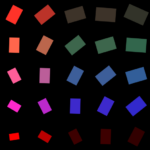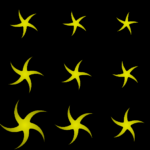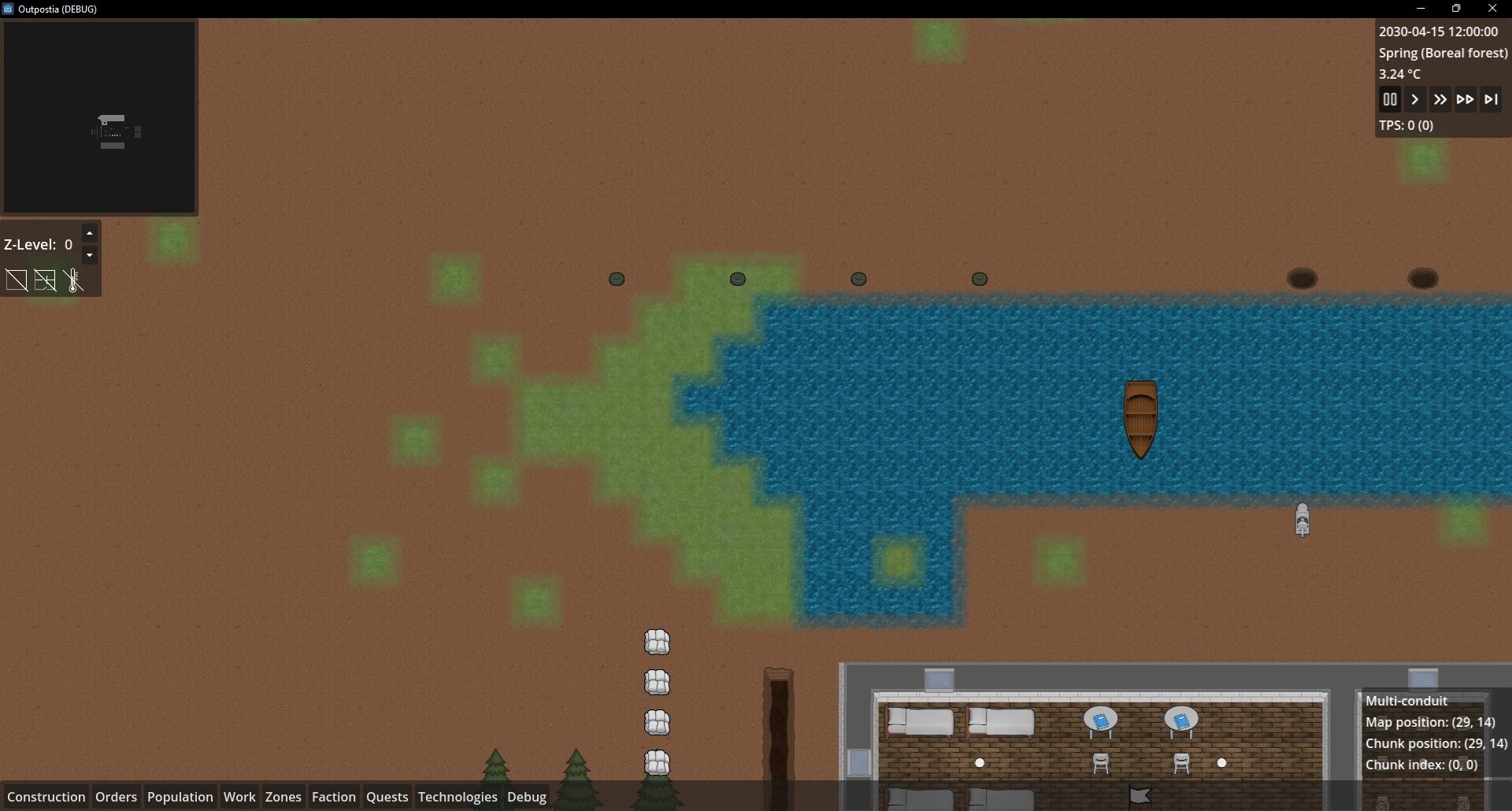Tile Based Triangles & Rects
Inspired by two “shadertoy” and one of “book of shaders” codes (Links are lowermost below). Heavily improved by adding time dependent changings such as rotation, scaling, color, noise, etc. Developed on square sprite like godot icon. Able to change a lot of things on, to play with. Done no optimisation yet.
Rectangled one can be viewed on shadertoy. Link to the Shadertoy View of the Shader.
Outsourced Library Functions with their lines in the Code
012 – Helper Functions for Noise Functions – Only OVERLOADING Changes
023 – Perlin Noise – NO CHANGE
062 – Simplex Noise – NO CHANGE
119 – HSB to RGB Conversion – NO CHANGE
129 – Smoothedge – NO CHANGE
127 – Rotate – NO CHANGE
130 – Rectangle – HEAVILY CHANGED
144 – Triangle – HEAVILY CHANGED
153 – Fragment – million CHANGES
Links to Inspired Codes
Many Spinning Mono Star-Flowers
Shader code
shader_type canvas_item;
// Combined Version of 2 Shaders below + SCALING + WOBBLING + DIFF.SPEEDS
// Many Spinning Mono Star-Flowers
// https://www.shadertoy.com/view/3dsSWN
// Spinning Rubber Gold Star
// https://www.shadertoy.com/view/wdlSW4
uniform vec2 iResolution = vec2 (75.0, 75.0);
const float TWO_PI = 6.28318530718;
// Helper Functions for Perlin Noise
vec4 mod289(vec4 x) { return x - floor(x * (1.0 / 289.0)) * 289.0; }
vec4 permute(vec4 x) { return mod289(((x*34.0)+1.0)*x); }
vec4 taylorInvSqrt(vec4 r) { return 1.79284291400159 - 0.85373472095314 * r; }
vec2 fade(vec2 t) { return t*t*t*(t*(t*6.0-15.0)+10.0); }
// Helper Functions for Simplex Noise
vec3 mod289S(vec3 x) { return x - floor(x * (1.0 / 289.0)) * 289.0; }
vec2 mod289_A(vec2 x) { return x - floor(x * (1.0 / 289.0)) * 289.0; }
vec3 permuteS(vec3 x) { return mod289S(((x*34.0)+1.0)*x); }
// Classic Perlin noise
float classicPerlin(vec2 P) {
vec4 Pi = floor(P.xyxy) + vec4(0.0, 0.0, 1.0, 1.0);
vec4 Pf = fract(P.xyxy) - vec4(0.0, 0.0, 1.0, 1.0);
Pi = mod289(Pi); // To avoid truncation effects in permutation
vec4 ix = Pi.xzxz;
vec4 iy = Pi.yyww;
vec4 fx = Pf.xzxz;
vec4 fy = Pf.yyww;
vec4 i = permute(permute(ix) + iy);
vec4 gx = fract(i * (1.0 / 41.0)) * 2.0 - 1.0 ;
vec4 gy = abs(gx) - 0.5 ;
vec4 tx = floor(gx + 0.5);
gx = gx - tx;
vec2 g00 = vec2(gx.x,gy.x);
vec2 g10 = vec2(gx.y,gy.y);
vec2 g01 = vec2(gx.z,gy.z);
vec2 g11 = vec2(gx.w,gy.w);
vec4 norm = taylorInvSqrt(vec4(dot(g00, g00), dot(g01, g01), dot(g10, g10), dot(g11, g11)));
g00 *= norm.x;
g01 *= norm.y;
g10 *= norm.z;
g11 *= norm.w;
float n00 = dot(g00, vec2(fx.x, fy.x));
float n10 = dot(g10, vec2(fx.y, fy.y));
float n01 = dot(g01, vec2(fx.z, fy.z));
float n11 = dot(g11, vec2(fx.w, fy.w));
vec2 fade_xy = fade(Pf.xy);
vec2 n_x = mix(vec2(n00, n01), vec2(n10, n11), fade_xy.x);
float n_xy = mix(n_x.x, n_x.y, fade_xy.y);
return 2.3 * n_xy;
}
// Description : GLSL 2D simplex noise function
// Author : Ian McEwan, Ashima Arts
// Maintainer : ijm
// Lastmod : 20110822 (ijm)
// License :
// Copyright (C) 2011 Ashima Arts. All rights reserved.
// Distributed under the MIT License. See LICENSE file.
// https://github.com/ashima/webgl-noise
float simplex(vec2 v) {
// Precompute values for skewed triangular grid
const vec4 C = vec4(0.211324865405187,
// (3.0-sqrt(3.0))/6.0
0.366025403784439,
// 0.5*(sqrt(3.0)-1.0)
-0.577350269189626,
// -1.0 + 2.0 * C.x
0.024390243902439);
// 1.0 / 41.0
// First corner (x0)
vec2 i = floor(v + dot(v, C.yy));
vec2 x0 = v - i + dot(i, C.xx);
// Other two corners (x1, x2)
vec2 i1 = vec2(0.0);
i1 = (x0.x > x0.y)? vec2(1.0, 0.0):vec2(0.0, 1.0);
vec2 x1 = x0.xy + C.xx - i1;
vec2 x2 = x0.xy + C.zz;
// Do some permutations to avoid
// truncation effects in permutation
i = mod289_A(i);
vec3 p = permuteS(
permuteS( i.y + vec3(0.0, i1.y, 1.0))
+ i.x + vec3(0.0, i1.x, 1.0 ));
vec3 m = max(0.5 - vec3(
dot(x0,x0),
dot(x1,x1),
dot(x2,x2)
), 0.0);
m = m*m ;
m = m*m ;
// Gradients:
// 41 pts uniformly over a line, mapped onto a diamond
// The ring size 17*17 = 289 is close to a multiple
// of 41 (41*7 = 287)
vec3 x = 2.0 * fract(p * C.www) - 1.0;
vec3 h = abs(x) - 0.5;
vec3 ox = floor(x + 0.5);
vec3 a0 = x - ox;
// Normalise gradients implicitly by scaling m
// Approximation of: m *= inversesqrt(a0*a0 + h*h);
m *= 1.79284291400159 - 0.85373472095314 * (a0*a0+h*h);
// Compute final noise value at P
vec3 g = vec3(0.0);
g.x = a0.x * x0.x + h.x * x0.y;
g.yz = a0.yz * vec2(x1.x,x2.x) + h.yz * vec2(x1.y,x2.y);
return 130.0 * dot(m, g);
}
vec3 hsb2rgb( in vec3 c ){
vec3 rgb = clamp(abs(mod(c.x*6.0+vec3(0.0,4.0,2.0),
6.0)-3.0)-1.0,
0.0,
1.0 );
rgb = rgb*rgb*(3.0-2.0*rgb);
return c.z * mix(vec3(1.0), rgb, c.y);
}
float smoothedge(float v, float res) {
return smoothstep(0.0, res, v);
}
vec2 rotate(vec2 v, float a) {
float s = sin(a);
float c = cos(a);
mat2 m = mat2(vec2(c, -s), vec2(s, c));
return m * v;
}
float rect(vec2 p, vec2 size, vec2 uvMain, float coef) {
p -= 0.5;
uvMain = uvMain * coef + 1.0;
float uvMainF = sqrt(floor(uvMain.x) + floor(uvMain.y));
p = rotate(p, uvMainF * (cos(TWO_PI * abs(fract(TIME / 10. - 0.5))) - 2.0)) ;
vec2 d = abs(p) - size * 0.25 * (sin(TIME) + 2.0) * uvMainF;
return min(max(d.x, d.y), 0.0) + length(max(d,0.0));
}
float triangle(vec2 p, float size, vec2 uvMain, float coef) {
p -= 0.5;
uvMain = uvMain * coef + 1.0;
float uvMainF = sqrt(floor(uvMain.x) + floor(uvMain.y));
p = rotate(p, uvMainF * (cos(TWO_PI * abs(fract(TIME / 20. - 0.5))) - 1.0)) ;
vec2 q = abs(p) - size * 0.25 * (sin(TIME) + 2.0) * uvMainF;
return max(q.x * 0.866025 + p.y * 0.5, -p.y * 0.5) - size * 0.5;
}
void fragment() {
vec2 uvMain = UV;
float fraction = 5.0;
vec2 uvFraction = fract(uvMain * fraction) + 0.5;
float d = 0.09;
d = min(d, rect(uvFraction - vec2(0.5, 0.5), vec2(0.15, .10), uvMain, fraction));
// d = min(d, triangle(uvFraction - vec2(0.5, 0.5), 0.09, uvMain, fraction));
float colorF = smoothedge(d, 1.0 / iResolution.x);
float hsbRG = hsb2rgb(vec3(ceil((1.0 - uvMain.x) * fraction)) / fraction).r;
vec2 hsbB = hsb2rgb(vec3(ceil((1.0 - uvMain.y) * fraction)) / fraction).gb;
vec3 color = vec3(1.0 - colorF)
* vec3(hsbRG, hsbB) * (classicPerlin(uvMain * cos(TIME*1.)) + .5);
d = triangle(uvFraction - vec2(0.5, 0.5), 0.09, (1. - uvMain), fraction);
colorF = smoothedge(d, 1.0 / iResolution.x);
hsbRG = hsb2rgb(vec3(ceil((uvMain.x) * fraction)) / fraction).r;
hsbB = hsb2rgb(vec3(ceil((uvMain.y) * fraction)) / fraction).gb;
color += vec3(1.0 - colorF)
* vec3(hsbRG, hsbB) * (simplex(uvMain * sin(TIME*1.)) + .5);
COLOR = vec4(color * 1.5, 1.0);
}









